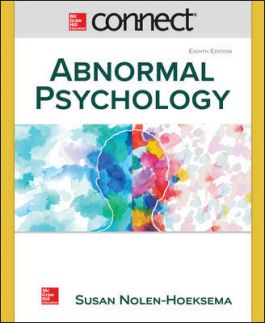No products in the cart.
Abnormal Psychology
Abnormal Psychology, 8e Susan Nolen-Hoeksema, Brett Marroquin, Test Bank
Test Bank
Book Name: Abnormal Psychology
Edition :8th Edition
Author name:Susan Nolen-Hoeksema, Brett Marroquin
contact:
Whatsapp +1 (949) 734-4773

$35.00 $50.00
Test Bank
Book Name: Abnormal Psychology
Edition :8th Edition
Author name:Susan Nolen-Hoeksema, Brett Marroquin
contact:
Whatsapp +1 (949) 734-4773

Abnormal Psychology, 8e (Nolen-Hoeksema)
Chapter 1 Looking at Abnormality
1) The continuum model of abnormality demonstrates that:
- A) there is a clear distinction between dysfunctional and deviant behavior.
- B) psychologists must make objective decisions about what warrants a diagnosis.
- C) individuals are labeled as either having a disorder or not having one.
- D) no sharp line exists between what is normal and abnormal.
2) To qualify as abnormal, behaviors, thoughts, and feelings must be
- A) diagnosable.
- B) unusual, distressing, impairing, or dangerous.
- C) identifiable in the DSM-5.
- D) violent.
3) When determining abnormality, behaviors, thoughts, and ________ are assessed.
- A) family history
- B) genetics
- C) feelings
- D) medication
4) The study of abnormal psychology is the study of people who suffer mental, emotional, and often physical pain. This is also referred to as
- A) psychopathology.
- B) psychometry.
- C) parapsychology.
- D) behavioral psychology.
5) Margaret is a 27-year-old soccer mom who never misses her daughter’s games. Her friends argue that her behavior is embarrassing, and she is making a fool of herself when she repeatedly yells and jumps to her feet. Margaret insists that no one is paying attention to her behavior and states, “It’s a soccer game—people are expected to get excited!” Which of the following determines whether Margaret’s behavior is normal?
- A) Her social status
- B) Gender differences
- C) The context in which it is performed
- D) Individual differences
6) When an observer takes into account the context or circumstances surrounding someone’s behavior to determine whether they are normal or abnormal, it means that:
- A) the observer assesses the behavior based on her/his own biases and prejudices.
- B) the observer considers the behavior normal if it seems appropriate for that particular situation.
- C) the observer judges the individual’s personality based on the observer’s cognitive abilities.
- D) the observer’s evaluation of the behavior lacks any theoretical grounding.
7) An advantage of cultural relativism is that:
- A) it does not impose the standards of one culture on judgments of abnormality.
- B) there is a tendency to view all behaviors that are unusual, or deviant, as abnormal.
- C) it allows those in power to label and silence minorities by labeling them as abnormal.
- D) it does not adopt a continuum perspective of abnormal behavior; rather, it is an either/or proposition.
8) Which criterion for abnormality implies that the presence of a disease is causing given behavior?
- A) Deviance
- B) Unusualness
- C) Distress
- D) Mental Illness
9) Rachel teaches the second grade and suspects that two students in her class have behavioral problems. Although she works fervently to keep the class running smoothly, the students’ behaviors continually disrupt the learning environment. When the two students blurt out the answers before being called upon, push others in line, or constantly get out of their seats, other students become distracted and irritated. According to which criterion will these students’ behaviors most likely be considered abnormal?
- A) Cultural relativism
- B) Mental illness
- C) Distress
- D) Gender relativism
10) What are “the four Ds” of abnormality?
- A) Distress, delusion, deviance, and derision
- B) Deviance, dysfunction, disorder, and danger
- C) Danger, disorder, delusion, and dysfunction
- D) Dysfunction, distress, deviance, and dangerousness
11) Theorists who argue that behaviors can only be abnormal relative to cultural norms, are proponents of:
- A) cultural hegemony.
- B) cultural regeneration.
- C) cultural imperialism.
- D) cultural relativism.
12) Cultural relativists argue that:
- A) behaviors must be universally accepted to be considered normal.
- B) context, and not culture, influences the evaluation of behaviors as abnormal.
- C) the use of gender roles as a basis for assessing abnormal behaviors can be misleading.
- D) no universal standards or rules exist for labeling behaviors as abnormal.
 Loading...
Loading...







Bryan (verified owner) –
Good service.
Bryan –
Nathaniel (verified owner) –
you saved my life
Nathaniel –